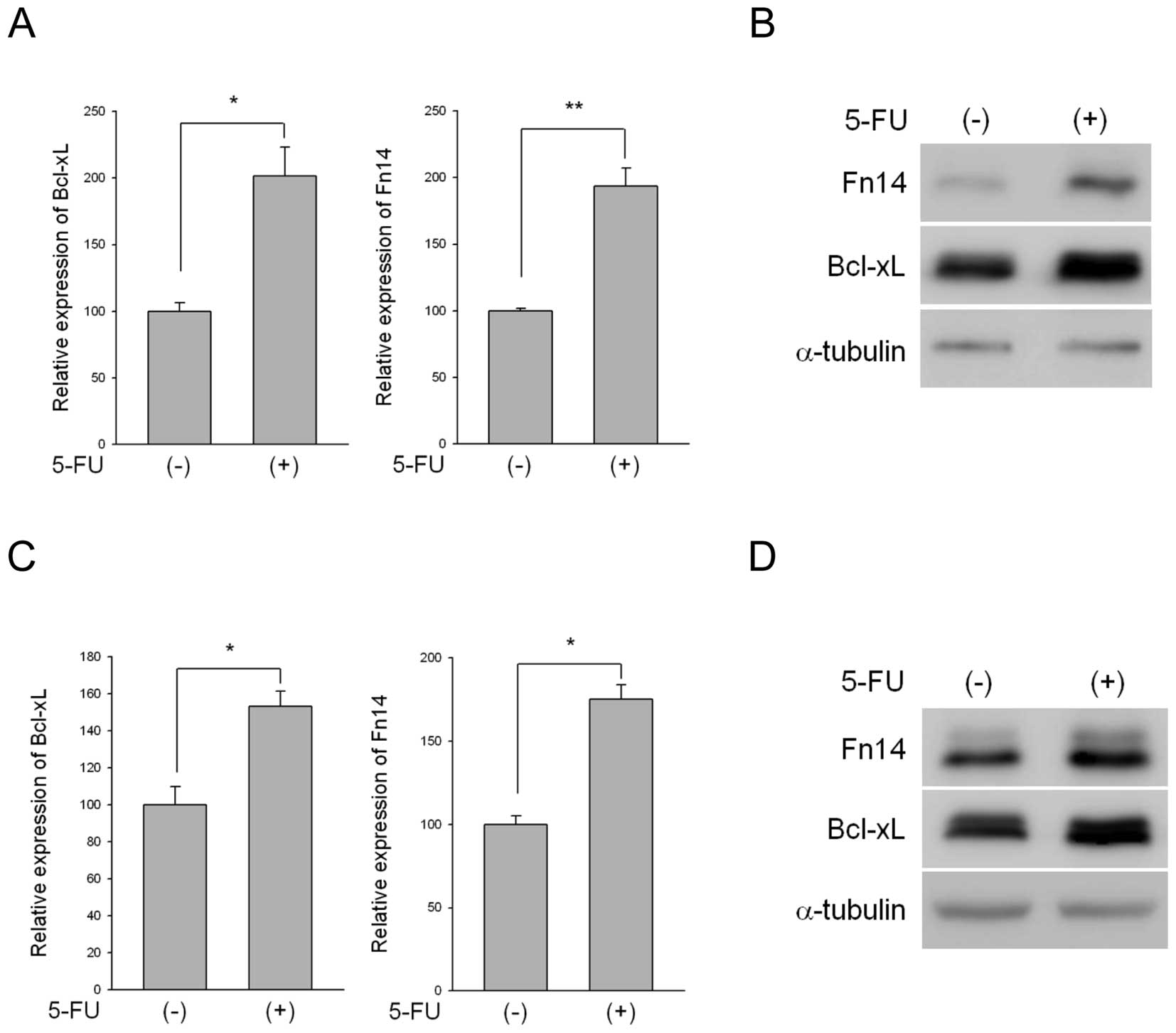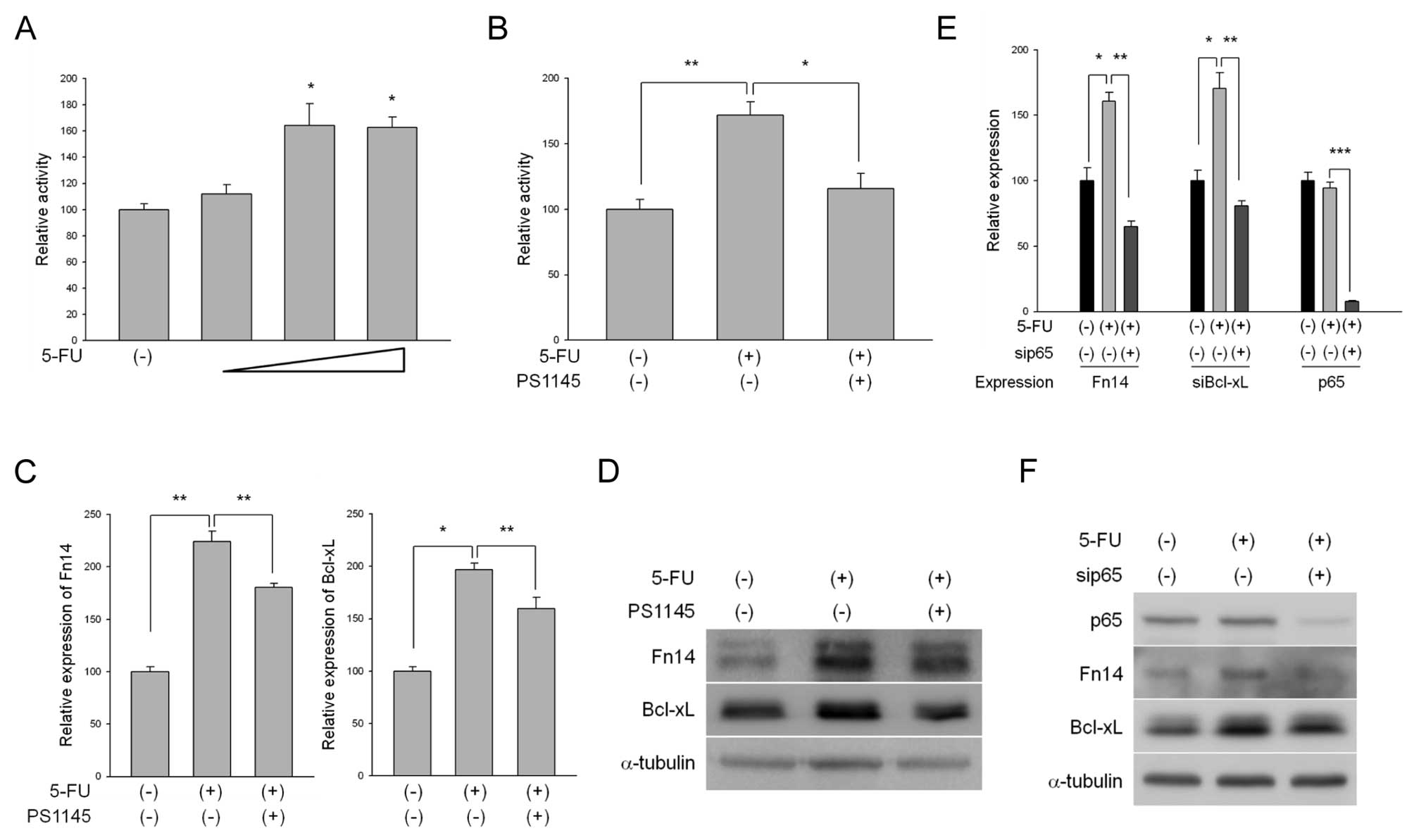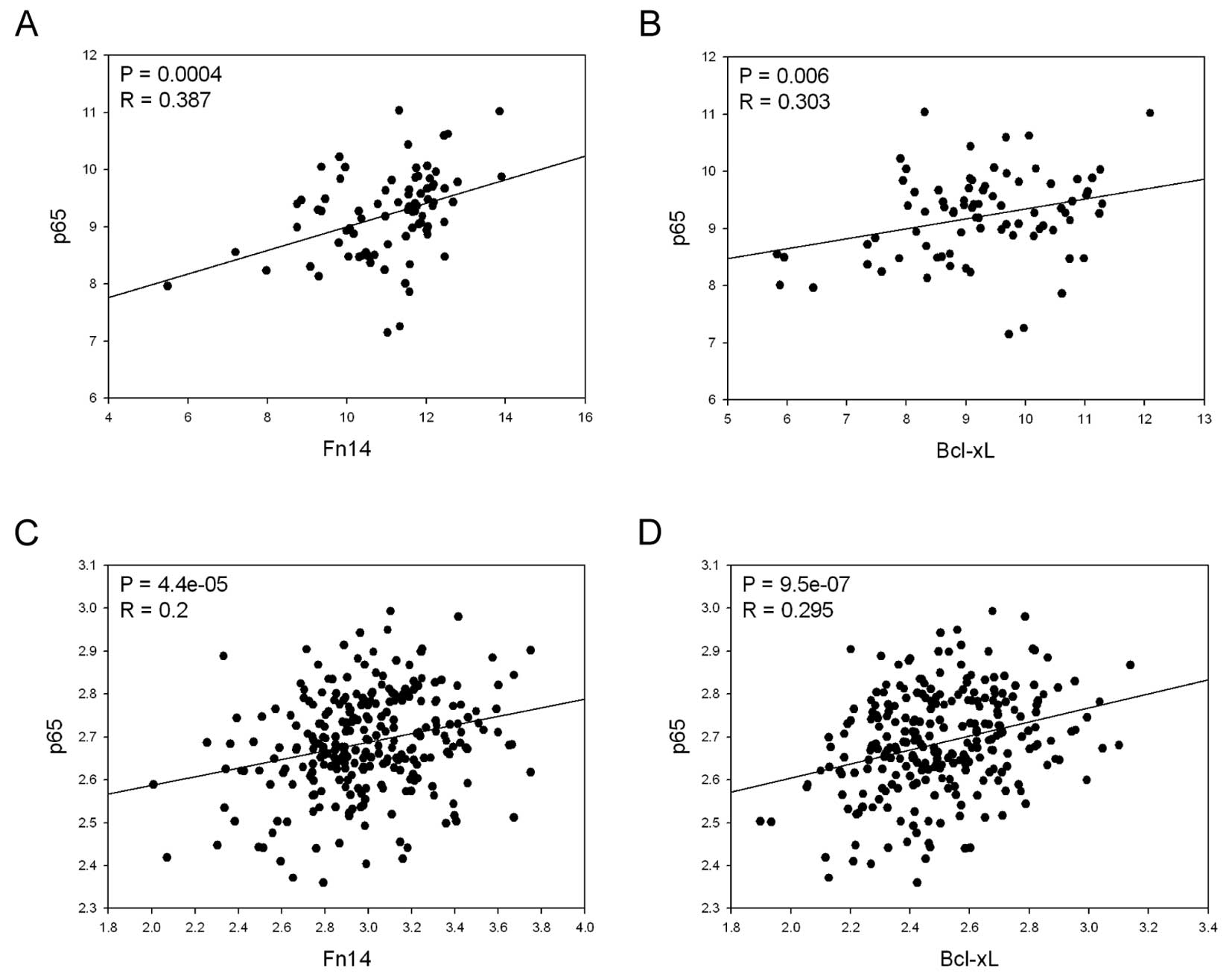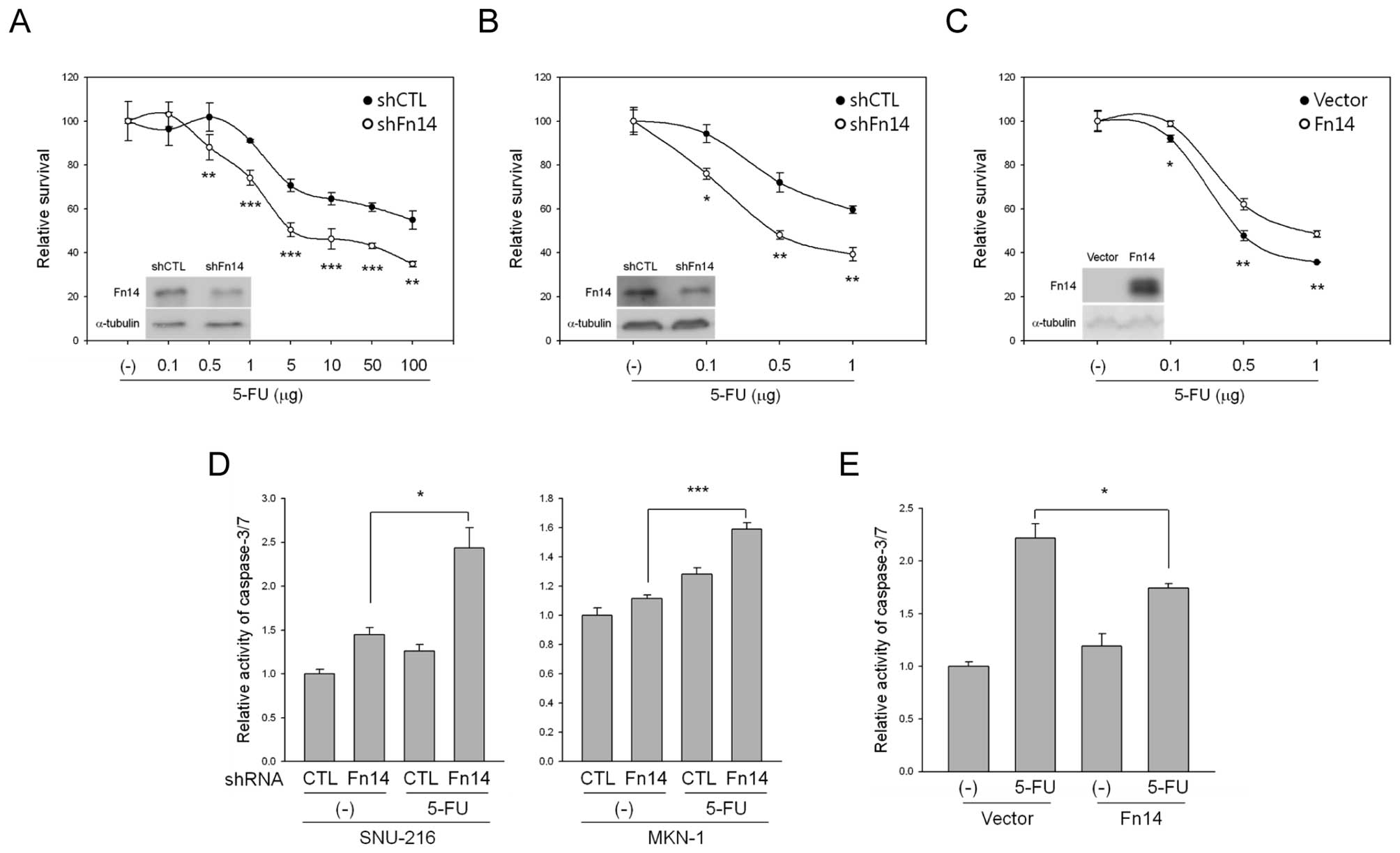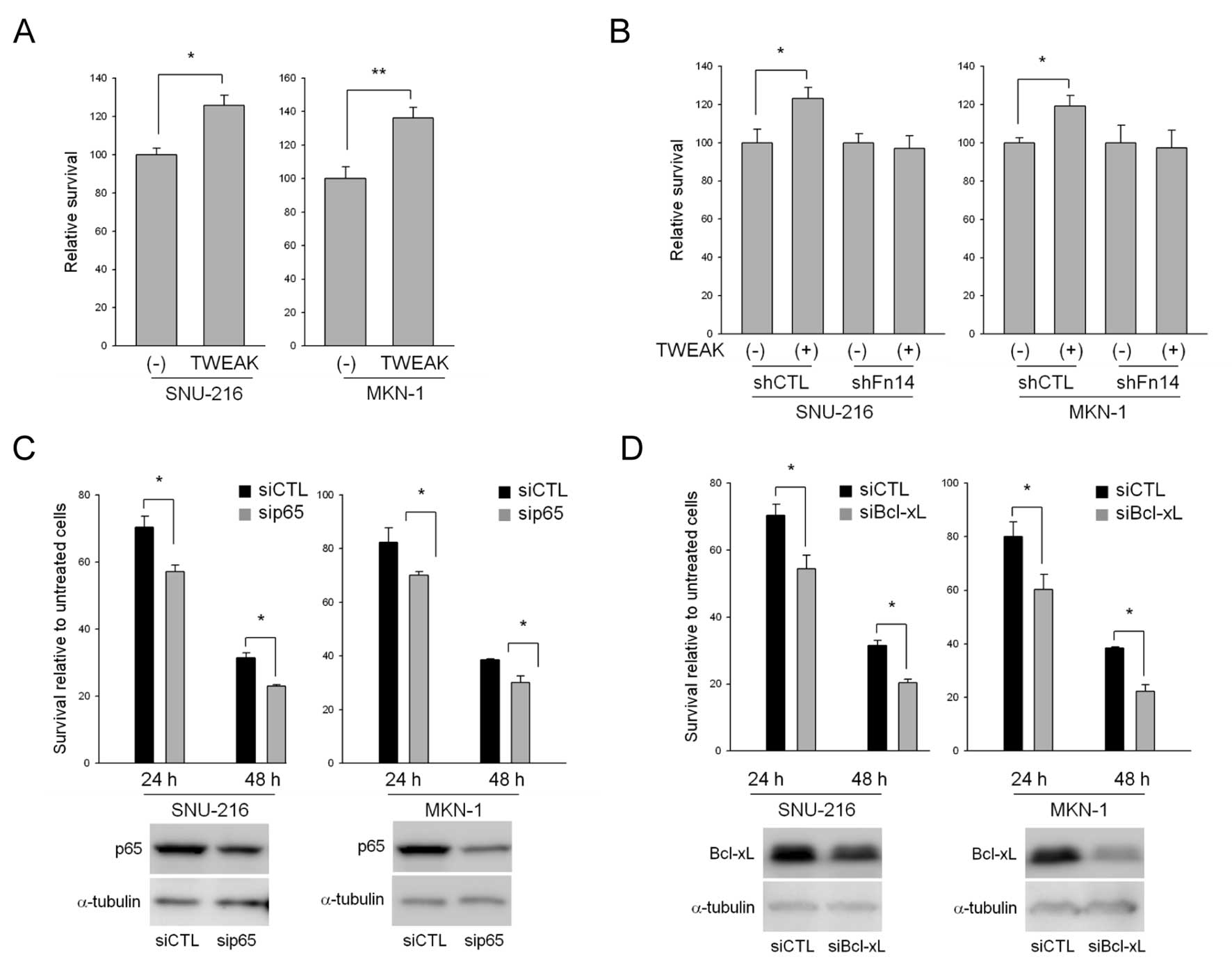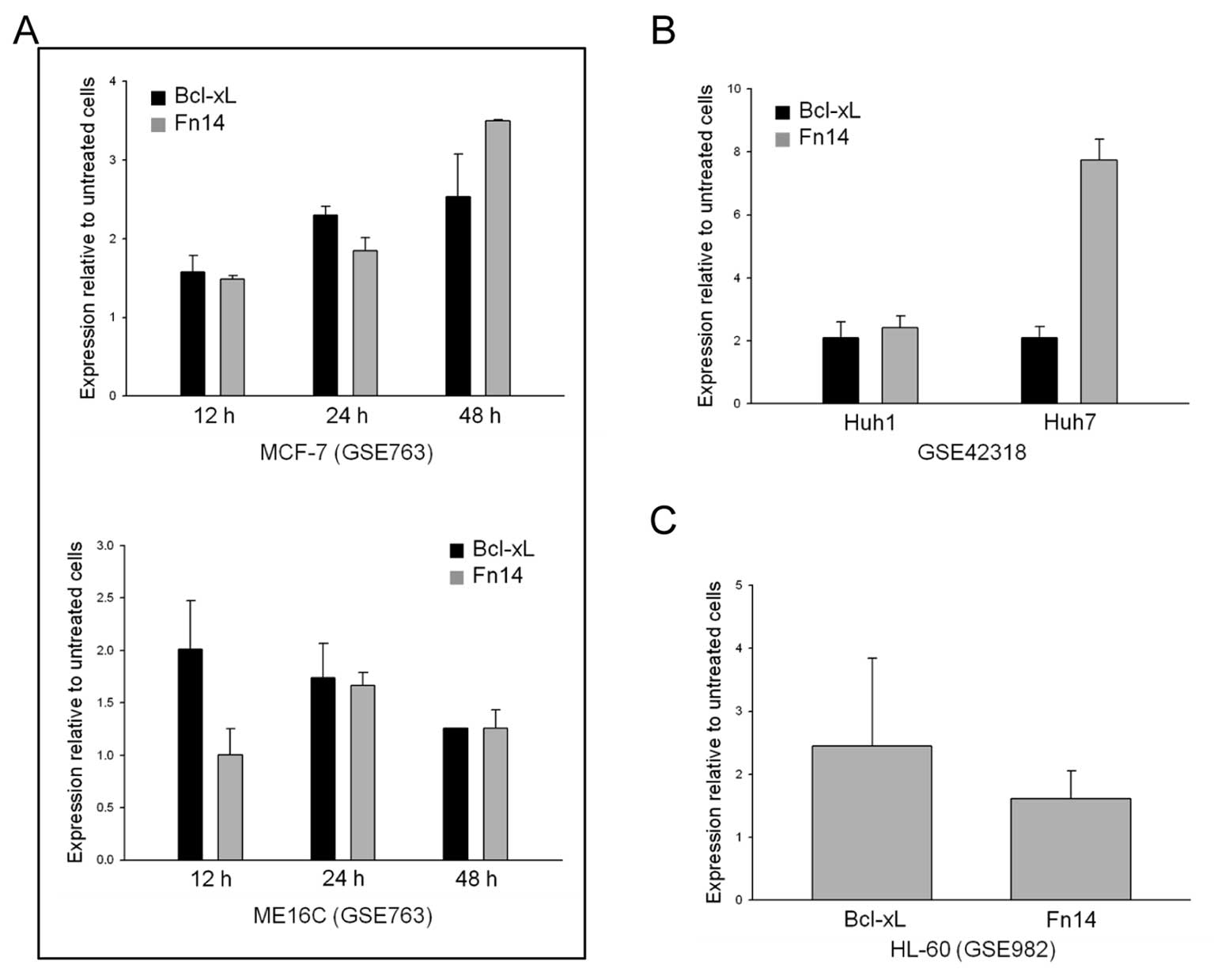|
1.
|
Meighan-Mantha RL, Hsu DK, Guo Y, et al:
The mitogeninducible Fn14 gene encodes a type I transmembrane
protein that modulates fibroblast adhesion and migration. J Biol
Chem. 274:33166–33176. 1999. View Article : Google Scholar : PubMed/NCBI
|
|
2.
|
Feng SL, Guo Y, Factor VM, et al: The Fn14
immediate-early response gene is induced during liver regeneration
and highly expressed in both human and murine hepatocellular
carcinomas. Am J Pathol. 156:1253–1261. 2000. View Article : Google Scholar : PubMed/NCBI
|
|
3.
|
Wiley SR, Cassiano L, Lofton T, et al: A
novel TNF receptor family member binds TWEAK and is implicated in
angiogenesis. Immunity. 15:837–846. 2001. View Article : Google Scholar : PubMed/NCBI
|
|
4.
|
Shin G, Kang TW, Yang S, Baek SJ, Jeong YS
and Kim SY: GENT: gene expression database of normal and tumor
tissues. Cancer Inform. 10:149–157. 2011.PubMed/NCBI
|
|
5.
|
Tran NL, McDonough WS, Donohue PJ, et al:
The human Fn14 receptor gene is up-regulated in migrating glioma
cells in vitro and overexpressed in advanced glial tumors. Am J
Pathol. 162:1313–1321. 2003. View Article : Google Scholar : PubMed/NCBI
|
|
6.
|
Kwon OH, Park SJ, Kang TW, et al: Elevated
fibroblast growth factor-inducible 14 expression promotes gastric
cancer growth via nuclear factor-kappaB and is associated with poor
patient outcome. Cancer Lett. 314:73–81. 2012. View Article : Google Scholar : PubMed/NCBI
|
|
7.
|
Huang M, Narita S, Tsuchiya N, et al:
Overexpression of Fn14 promotes androgen-independent prostate
cancer progression through MMP-9 and correlates with poor treatment
outcome. Carcinogenesis. 32:1589–1596. 2011. View Article : Google Scholar : PubMed/NCBI
|
|
8.
|
Zhou H, Ekmekcioglu S, Marks JW, et al:
The TWEAK receptor Fn14 is a therapeutic target in melanoma:
immunotoxins targeting Fn14 receptor for malignant melanoma
treatment. J Invest Dermatol. 133:1052–1062. 2013. View Article : Google Scholar : PubMed/NCBI
|
|
9.
|
Silverman N and Maniatis T: NF-kappaB
signaling pathways in mammalian and insect innate immunity. Genes
Dev. 15:2321–2342. 2001. View Article : Google Scholar : PubMed/NCBI
|
|
10.
|
Karin M: Nuclear factor-kappaB in cancer
development and progression. Nature. 441:431–436. 2006. View Article : Google Scholar : PubMed/NCBI
|
|
11.
|
Karin M and Lin A: NF-kappaB at the
crossroads of life and death. Nat Immunol. 3:221–227. 2002.
View Article : Google Scholar : PubMed/NCBI
|
|
12.
|
Wang CY, Cusack JC Jr, Liu R and Baldwin
AS Jr: Control of inducible chemoresistance: enhanced anti-tumor
therapy through increased apoptosis by inhibition of NF-kappaB. Nat
Med. 5:412–417. 1999. View
Article : Google Scholar : PubMed/NCBI
|
|
13.
|
Saitoh T, Nakayama M, Nakano H, Yagita H,
Yamamoto N and Yamaoka S: TWEAK induces NF-kappaB2 p100 processing
and long lasting NF-kappaB activation. J Biol Chem.
278:36005–36012. 2003. View Article : Google Scholar : PubMed/NCBI
|
|
14.
|
Sevilla L, Zaldumbide A, Pognonec P and
Boulukos KE: Transcriptional regulation of the bcl-x gene encoding
the anti-apoptotic Bcl-xL protein by Ets, Rel/NFkappaB, STAT and
AP1 transcription factor families. Histol Histopathol. 16:595–601.
2001.PubMed/NCBI
|
|
15.
|
Johnstone RW, Ruefli AA and Lowe SW:
Apoptosis: a link between cancer genetics and chemotherapy. Cell.
108:153–164. 2002. View Article : Google Scholar : PubMed/NCBI
|
|
16.
|
Jemal A, Bray F, Center MM, Ferlay J, Ward
E and Forman D: Global cancer statistics. CA Cancer J Clin.
61:69–90. 2011. View Article : Google Scholar
|
|
17.
|
Sun Y, Tang XM, Half E, Kuo MT and
Sinicrope FA: Cyclooxygenase-2 overexpression reduces apoptotic
susceptibility by inhibiting the cytochrome c-dependent apoptotic
pathway in human colon cancer cells. Cancer Res. 62:6323–6328.
2002.PubMed/NCBI
|
|
18.
|
Martinou JC, Desagher S and Antonsson B:
Cytochrome c release from mitochondria: all or nothing. Nat Cell
Biol. 2:E41–E43. 2000. View
Article : Google Scholar : PubMed/NCBI
|
|
19.
|
Livak KJ and Schmittgen TD: Analysis of
relative gene expression data using real-time quantitative PCR and
the 2(-Delta Delta C(T)) method. Methods. 25:402–408. 2001.
View Article : Google Scholar : PubMed/NCBI
|
|
20.
|
Fukuyama R, Ng KP, Cicek M, et al: Role of
IKK and oscillatory NFkappaB kinetics in MMP-9 gene expression and
chemoresistance to 5-fluorouracil in RKO colorectal cancer cells.
Mol Carcinog. 46:402–413. 2007. View
Article : Google Scholar : PubMed/NCBI
|
|
21.
|
Tran NL, McDonough WS, Savitch BA, et al:
Increased fibroblast growth factor-inducible 14 expression levels
promote glioma cell invasion via Rac1 and nuclear factor-kappaB and
correlate with poor patient outcome. Cancer Res. 66:9535–9542.
2006. View Article : Google Scholar : PubMed/NCBI
|
|
22.
|
Konishi T, Sasaki S, Watanabe T, Kitayama
J and Nagawa H: Overexpression of hRFI inhibits
5-fluorouracil-induced apoptosis in colorectal cancer cells via
activation of NF-kappaB and upregulation of BCL-2 and BCL-XL.
Oncogene. 25:3160–3169. 2006. View Article : Google Scholar : PubMed/NCBI
|
|
23.
|
Tran NL, McDonough WS, Savitch BA, Sawyer
TF, Winkles JA and Berens ME: The tumor necrosis factor-like weak
inducer of apoptosis (TWEAK)-fibroblast growth factor-inducible 14
(Fn14) signaling system regulates glioma cell survival via NFkappaB
pathway activation and BCL-XL/BCL-W expression. J Biol Chem.
280:3483–3492. 2005. View Article : Google Scholar
|
|
24.
|
Polek TC, Talpaz M, Darnay BG and
Spivak-Kroizman T: TWEAK mediates signal transduction and
differentiation of RAW264.7 cells in the absence of Fn14/TweakR.
Evidence for a second TWEAK receptor J Biol Chem. 278:32317–32323.
2003.PubMed/NCBI
|
|
25.
|
Garg A and Aggarwal BB: Nuclear
transcription factor-kappaB as a target for cancer drug
development. Leukemia. 16:1053–1068. 2002. View Article : Google Scholar : PubMed/NCBI
|
|
26.
|
Escarcega RO, Fuentes-Alexandro S,
Garcia-Carrasco M, Gatica A and Zamora A: The transcription factor
nuclear factor-kappa B and cancer. Clin Oncol (R Coll Radiol).
19:154–161. 2007. View Article : Google Scholar : PubMed/NCBI
|
|
27.
|
Dolcet X, Llobet D, Pallares J and
Matias-Guiu X: NF-κB in development and progression of human
cancer. Virchows Arch. 446:475–482. 2005.
|
|
28.
|
Reed JC: Bcl-2 family proteins: regulators
of apoptosis and chemoresistance in hematologic malignancies. Semin
Hematol. 34:9–19. 1997.PubMed/NCBI
|
|
29.
|
Zhu H, Guo W, Zhang L, et al: Bcl-XL small
interfering RNA suppresses the proliferation of
5-fluorouracil-resistant human colon cancer cells. Mol Cancer Ther.
4:451–456. 2005.PubMed/NCBI
|
|
30.
|
Lei X, Huang Z, Zhong M, Zhu B, Tang S and
Liao D: Bcl-XL small interfering RNA sensitizes cisplatin-resistant
human lung adenocarcinoma cells. Acta Biochim Biophys Sin.
39:344–350. 2007. View Article : Google Scholar : PubMed/NCBI
|
|
31.
|
Whitsett TG, Cheng E, Inge L, et al:
Elevated expression of Fn14 in non-small cell lung cancer
correlates with activated EGFR and promotes tumor cell migration
and invasion. Am J Pathol. 181:111–120. 2012. View Article : Google Scholar : PubMed/NCBI
|
|
32.
|
Willis AL, Tran NL, Chatigny JM, et al:
The fibroblast growth factor-inducible 14 receptor is highly
expressed in HER2-positive breast tumors and regulates breast
cancer cell invasive capacity. Mol Cancer Res. 6:725–734. 2008.
View Article : Google Scholar : PubMed/NCBI
|
|
33.
|
Merkhofer EC, Cogswell P and Baldwin AS:
Her2 activates NF-kappaB and induces invasion through the canonical
pathway involving IKKalpha. Oncogene. 29:1238–1248. 2010.
View Article : Google Scholar : PubMed/NCBI
|
|
34.
|
Tsai CM, Yu D, Chang KT, et al: Enhanced
chemoresistance by elevation of p185neu levels in
HER-2/neu-transfected human lung cancer cells. J Natl Cancer Inst.
87:682–684. 1995. View Article : Google Scholar : PubMed/NCBI
|
|
35.
|
Gusterson BA, Gelber RD, Goldhirsch A, et
al: Prognostic importance of c-erbB-2 expression in breast cancer.
International (Ludwig) Breast Cancer Study Group J Clin Oncol.
10:1049–1056. 1992.PubMed/NCBI
|
|
36.
|
Munoz-Garcia B, Martin-Ventura JL,
Martinez E, et al: Fn14 is upregulated in cytokine-stimulated
vascular smooth muscle cells and is expressed in human carotid
atherosclerotic plaques: modulation by atorvastatin. Stroke.
37:2044–2053. 2006. View Article : Google Scholar
|
|
37.
|
Ortego M, Bustos C, Hernandez-Presa MA, et
al: Atorvastatin reduces NF-kappaB activation and chemokine
expression in vascular smooth muscle cells and mononuclear cells.
Atherosclerosis. 147:253–261. 1999. View Article : Google Scholar : PubMed/NCBI
|
|
38.
|
Muerkoster S, Wegehenkel K, Arlt A, et al:
Tumor stroma interactions induce chemoresistance in pancreatic
ductal carcinoma cells involving increased secretion and paracrine
effects of nitric oxide and interleukin-1beta. Cancer Res.
64:1331–1337. 2004. View Article : Google Scholar
|



